Mississippi is known for its blues music, access to the river with which it shares a name, and its modern agricultural prowess. The rural and urban areas of this state are rife with interesting animals, including fish, snakes, and even spiders. We’re going to focus on the latter. Specifically, this article will focus on identifying the five biggest spiders in Mississippi. If you’re ready to learn about the arachnids with the biggest bodies and longest legs, then read on!
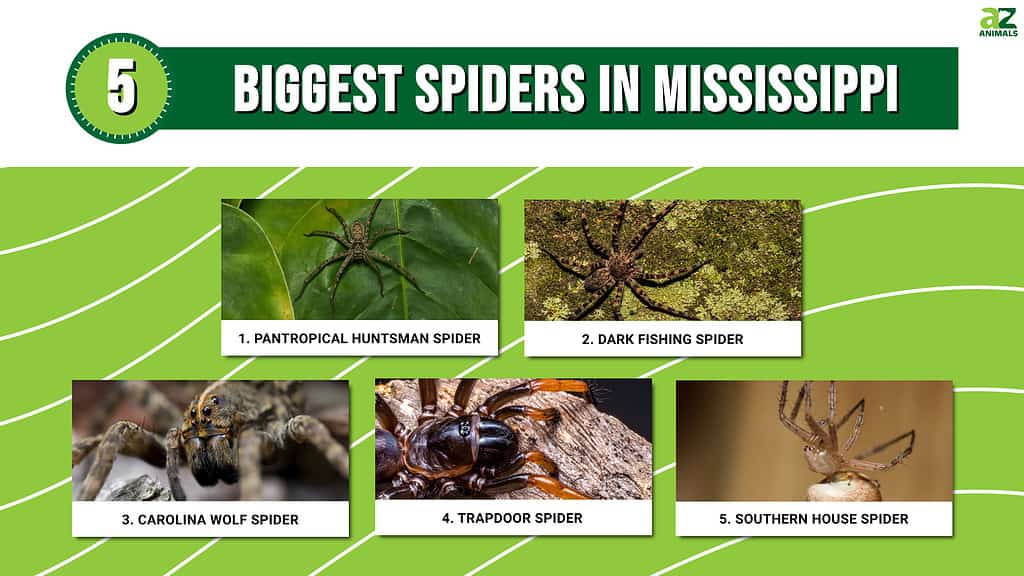
What Are the Biggest Spiders in Mississippi?
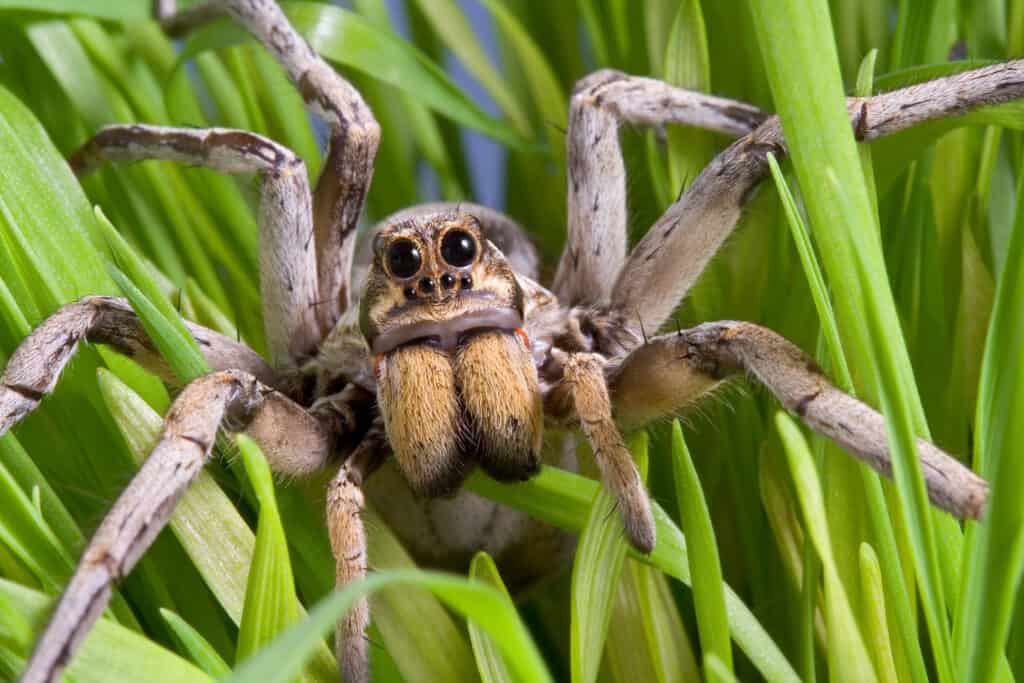
Wolf spiders have long legs and big bodies.
©iStock.com/CathyKeifer
When we’re talking about the biggest spiders in Mississippi, it’s more of a contest of leg length. After all, if we went by body length, we’d be missing the vast majority of the spider’s overall size. With that in mind, we’re also going to focus on identifying the spider by size and looks. We’ll also talk about what happens if this spider bites a person, so you know if these creatures pose a threat to you.
5. Southern House Spider
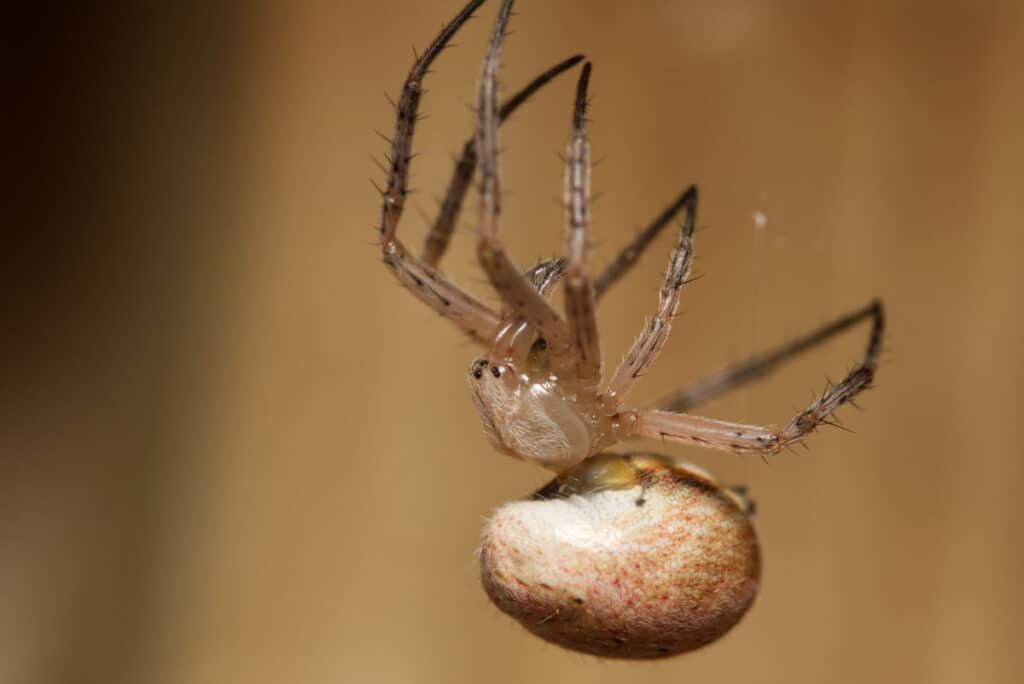
Southern house spiders often get mistaken for brown recluses due to their similar markings.
©Kala Stuwe/Shutterstock.com
| Scientific Name | Size | Danger to Humans |
|---|---|---|
| Kukulcania hibernalis | 0.75-2 inches | Their bite is mildly painful and leaves a bump. Sometimes, the pain can linger. |
The southern house spider is an unwelcome guest in many homes. It looks too similar to a brown recluse for most people to tolerate them. Given that spider’s reputation, it’s fair to want to squish it. These spiders are mostly found in homes, especially in small crevices.
Like the brown recluse, these spiders are brown and have a small marking on their cephalothorax. The brown recluse has a much more prominent marking on this part of its body, but you probably don’t want to get close enough to check.
The southern house spider can bite humans, but it won’t do much damage. Their bites will leave a bump and can cause mild pain. The pain usually dissipates rather quickly, though.
4. Trapdoor Spider
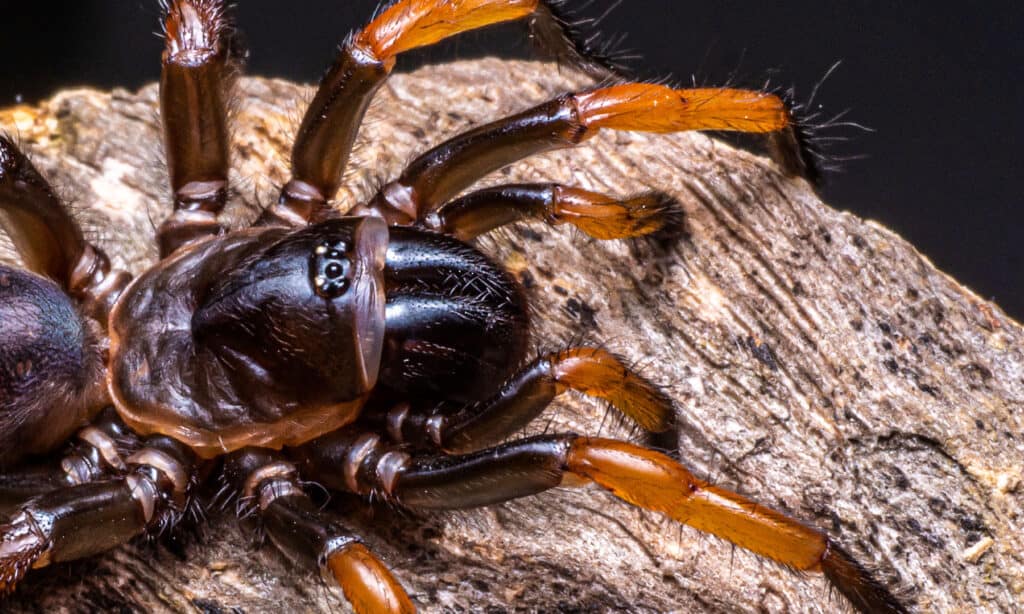
Trapdoor spiders have powerful, relatively short legs that they use to burrow.
©nokkaew/Shutterstock.com
| Scientific Name | Size | Danger to Humans |
|---|---|---|
| Ummidia Genus | 1-2 inches | Delivers a mildly painful bite. |
The trapdoor spider of the Ummidia genus only measures about 2 inches long, but over an inch of that is its body rather than its legs. These spiders are known for their black or dark brown bodies, shiny carapace, and legs.
It’s easy to confuse these for tarantulas when you don’t account for the size. However, they are hard to spot. As their name suggests, these spiders like to live in a burrow they dig out and construct with their powerful legs. They construct a door that swings open so they can burst forth to capture their prey as they walk by.
These spiders are usually found in forested areas and places with vegetation. Although they may look rather scary, their bite is not that terrible. It’ll inflict some mild pain and leave a mark, but that’s about all.
3. Carolina Wolf Spider
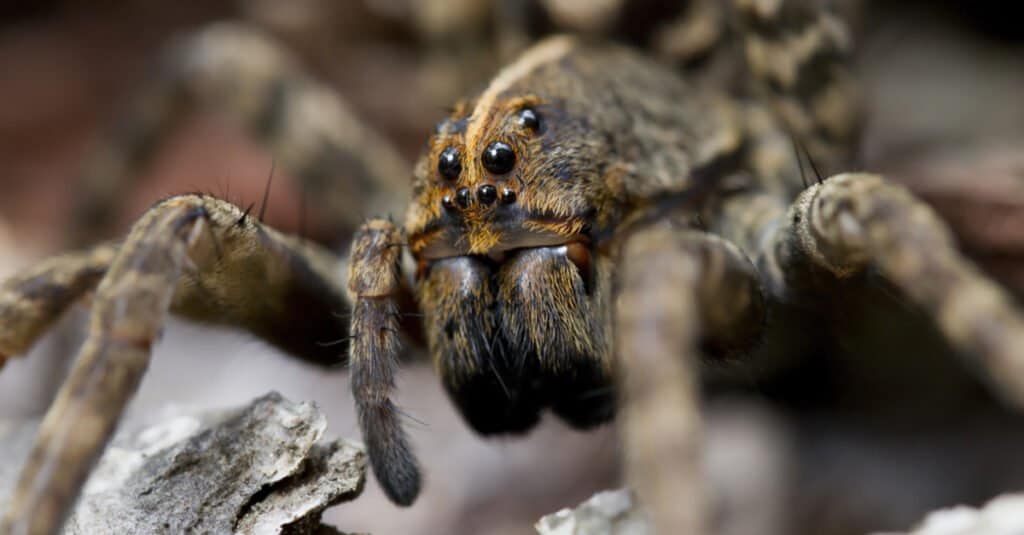
The Carolina wolf spider is the biggest member of its family.
©Will E. Davis/Shutterstock.com
| Scientific Name | Size | Danger to Humans |
|---|---|---|
| Hogna carolinensis | 2-4 inches | The bite from this spider causes local pain and swelling. |
The Carolina wolf spider is certainly one of the biggest spiders in Mississippi, but it’s not the largest. This wolf spider usually appears in a brown to dark brown color with even darker markings along its mottled body. However, it has some clear markings that help differentiate them from other spiders.
For example, they will have a cephalothorax with two dark markings covering the highest eyes on their “heads” and running down the rest of the cephalothorax. Some males may possess orange on the sides of their abdomen.
Although their bodies are large and their leg span is impressive, these spiders can look even bigger when a female is hefting an egg sac or carrying her young on her back. These wolf spiders are nocturnal, wandering hunters. You can find them in the dark recesses of homes and in other areas that are hidden outside, such as tall grass. You’ll also find them under rocks or around logs.
A wolf spider bite can be painful and cause swelling at the site. However, these bites can also be even more harmful if a person is allergic to their venom. In that case, the bitten person can experience more severe symptoms like headaches, rash, nausea, and muscle cramps.
2. Dark Fishing Spider
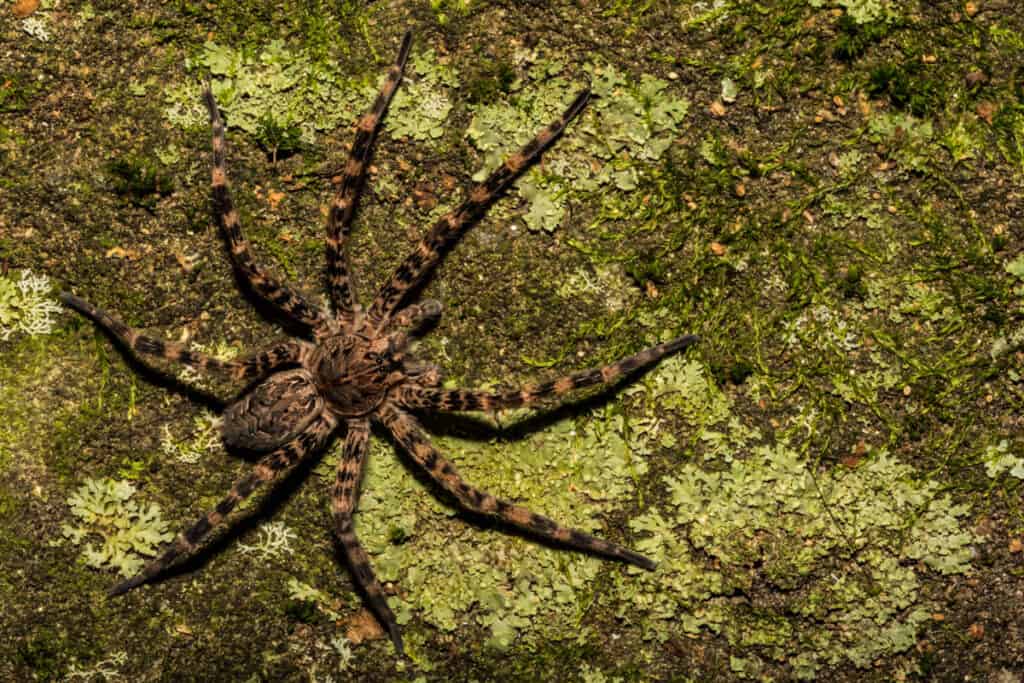
The dark fishing spider can run across the surface of water or dive into the water to catch prey.
©iStock.com/JasonOndreicka
| Scientific Name | Size | Danger to Humans |
|---|---|---|
| Dolomedes tenebrosus | 3.5-4.5 inches | Can bite humans and cause pain similar to a bee sting. |
The dark fishing spider is a very large spider that has a leg span that can reach over 4 inches long! This spider is not only big, but it causes concern in people because it’s a fast mover that doesn’t always stay near water like most other fishing spiders.
These creatures usually frighten people because they resemble wolf spiders. They often have bottled black and brown bodies, with noticeable W-shaped patterns on the abdomen. The patterns sometimes integrate a light color, like white, into them. The spider’s legs may have black chevrons on the brown background on the femur, but they change into banded black and brown colors on the tibia.
Bites from these spiders are exceedingly rare. Fishing spiders want nothing to do with human beings for the most part. However, if you do get bitten, the experience is said to be similar to a bee sting in terms of pain.
1. Pantropical Huntsman Spider
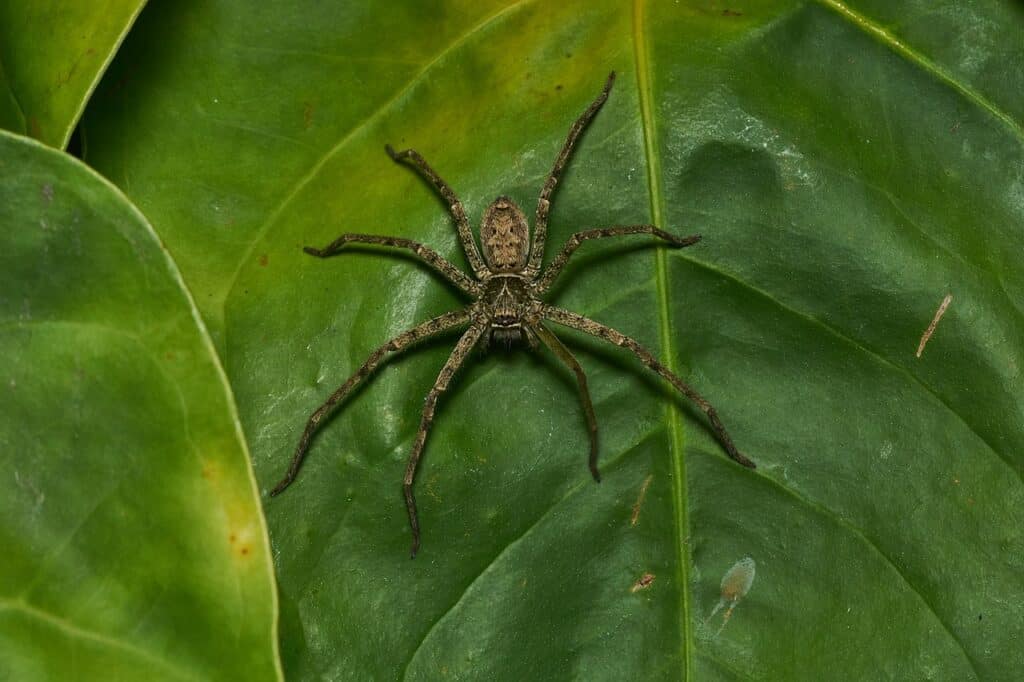
Pantropical huntsman spiders can measure nearly 12 centimeters long with their legs extended.
©© 2017 Jee & Rani Nature Photography / CC BY-SA 4.0 via Wikimedia Commons – License
| Scientific Name | Size | Danger to Humans |
|---|---|---|
| Heteropoda venatoria | 4-5 inches | Have a mildly painful bite that can cause swelling and sometimes a headache. |
The pantropical huntsman spider is the biggest in Mississippi, and it was accidentally introduced into the U.S. due to international trade. These spiders can grow very large, sometimes up to 5 inches or more in their leg span. They also have a body measuring about 1 inch.
Their bites are not dangerous to people, and the spiders aren’t overly aggressive. A bite will cause swelling and pain in the afflicted area, which can sometimes cause the individual to have a headache. Aside from that, their bites aren’t especially harmful.
These creatures are typically brown with a light-colored circle running around most of the carapace, a dark pattern on the middle portion of the cephalothorax, a light area immediately behind the eyes, and a black stripe in the middle of their abdomen.
These spiders live in homes, barns, and other places where they can stay warm during the winter. They cannot survive the cold very well since they’re not adapted for it. Nevertheless, their sudden appearance in someone’s home is bound to be met with fright.
Although the biggest spiders in Mississippi aren’t very dangerous, some dangerous species exist. For example, the black widow and brown recluse live in this area, the two most dangerous spiders in the U.S. They are joined by the yellow sac spider and the brown widow, both of which can deliver a painful bite. Give these creatures the space they deserve, and you should remain safe.
Summary of the 5 Biggest Spiders in Mississippi
Here’s a recap of the five largest spider species found in Mississippi that we took a look at.
| Rank | Common Name | Scientific Name | Size |
|---|---|---|---|
| 1 | Pantropical Huntsman Spider | Heteropoda venatoria | 4-5 inches |
| 2 | Dark Fishing Spider | Dolomedes tenebrosus | 3.5-4.5 inches |
| 3 | Carolina Wolf Spider | Hogna carolinensis | 2-4 inches |
| 4 | Trapdoor Spider | Ummidia Genus | 1-2 inches |
| 5 | Southern House Spider | Kukulcania hibernalis | .75-2 inches |
The photo featured at the top of this post is © © 2017 Jee & Rani Nature Photography / CC BY-SA 4.0 via Wikimedia Commons – License / Original
Sources
- University of Wisconsin, Available here: https://uwm.edu/field-station/dark-fishing-spider/
- Web MD, Available here: https://www.webmd.com/a-to-z-guides/what-you-need-to-know-about-a-wolf-spider-bite#:~:text=%E2%80%8CWolf%20spiders%20don't%20pose,it%20shouldn't%20last%20long
- Arthropod Museum, Available here: https://arthropod.uark.edu/trapdoor-spider/
- University of Florida, Available here: https://entnemdept.ufl.edu/creatures/urban/spiders/southern_house_spider.htm
Thank you for reading! Have some feedback for us? Contact the AZ Animals editorial team.






